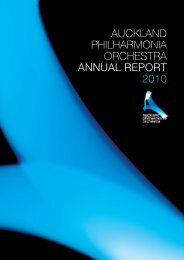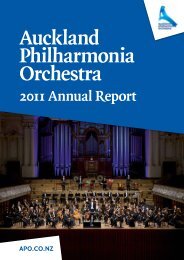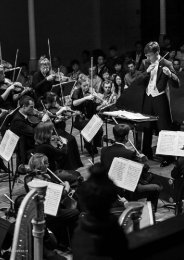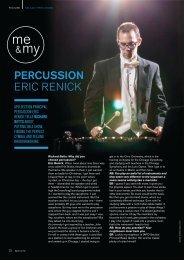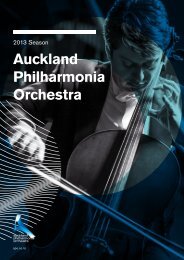Auckland Philharmonia Orchestra - the Auckland Philharmonia
Auckland Philharmonia Orchestra - the Auckland Philharmonia
Auckland Philharmonia Orchestra - the Auckland Philharmonia
Create successful ePaper yourself
Turn your PDF publications into a flip-book with our unique Google optimized e-Paper software.
model is still used in most formerly communist states, but a softer version of it has appeared ino<strong>the</strong>r countries such as Belgium, Spain and Mexico. Interestingly, in all of <strong>the</strong>se cases <strong>the</strong> countriesare highly federalised, with diverse and conflicting local populations. In <strong>the</strong>se countries it wouldappear to be politically expedient to form a non‐ethnic national orchestra in <strong>the</strong> capital which canrepresent <strong>the</strong> country internationally without exacerbating cultural divisions. Belgium’s mainorchestras, for example, are <strong>the</strong> Royal Flemish Philharmonic, <strong>the</strong> Chamber <strong>Orchestra</strong> of Wallonie,<strong>the</strong> Liege Philharmonic and, arguably, <strong>the</strong> orchestra of <strong>the</strong> Flemish Opera, ra<strong>the</strong>r than <strong>the</strong> BelgianNational <strong>Orchestra</strong>. Spain and Mexico both support a vibrant orchestral culture at <strong>the</strong> provinciallevel and <strong>the</strong> national orchestra in each case is more an expression of <strong>the</strong> unity and centralisation of<strong>the</strong> state than something fulfilling an o<strong>the</strong>rwise unoccupied niche.2.2 Radio <strong>Orchestra</strong>sAno<strong>the</strong>r evolutionary path for many national orchestras lay through <strong>the</strong> national broadcaster. In <strong>the</strong>early days of radio, national broadcasters, being substantial institutions in <strong>the</strong>ir own right, were <strong>the</strong>best equipped to become purveyors of live and broadcast music. Most large broadcasters retainedat least one orchestra, and some, like <strong>the</strong> BBC, retained several. In Australia and Germany, eachstate had its own orchestra attached to <strong>the</strong> state chapter of <strong>the</strong> national broadcaster. Although anumber of orchestras around <strong>the</strong> world remain radio orchestras, notably in Italy, Britain, Brazil andGermany, many orchestras devolved from <strong>the</strong>ir national broadcasters to take on an independentexistence. In some cases where it was clearly appropriate, <strong>the</strong> former radio orchestra took on <strong>the</strong>mantle of national orchestra. This has happened in places like Ireland, France, Portugal andDenmark, where “national” tends to be in contradistinction to “local” – that is to say that <strong>the</strong>national orchestras have a specific mission to develop orchestral music, promote artists or preserve<strong>the</strong> national orchestral tradition. This is especially <strong>the</strong> case with <strong>the</strong> Orchestre National de Franceand <strong>the</strong> Irish orchestra, formerly <strong>the</strong> RTE <strong>Orchestra</strong>. This does not give <strong>the</strong>m a physical presencenationally and this is not necessarily seen as part of <strong>the</strong>ir remit. Most of <strong>the</strong> former radio orchestrasretain connections with <strong>the</strong> radio networks, and tend to broadcast ra<strong>the</strong>r than tour <strong>the</strong> country,although <strong>the</strong> Irish National Symphony <strong>Orchestra</strong> does undertake one regional tour per year.3 Functions of National orchestras3.1 Ambassadorial functionIn both <strong>the</strong> above models, <strong>the</strong> concept of a “national orchestra” is primarily designed to indicate anexternal relation ra<strong>the</strong>r than an internal one. That is to say, <strong>the</strong> orchestra is first and foremost anambassador of sorts ra<strong>the</strong>r than something designed to function within <strong>the</strong> country itself. It isnoticeable that where <strong>the</strong>re is a single orchestra, or a number of orchestras within a country thatcan serve <strong>the</strong> ambassadorial purpose without causing political problems, a national orchestra is notapparently regarded as necessary – see for example Holland, Norway, Finland or Canada.3.2 Domestic functionNational <strong>Orchestra</strong>s with a specific domestic purpose are extremely unusual. Several nationalorchestras tour to one or more centres outside of <strong>the</strong>ir base. The Brazilian orchestra is based in Riode Janiero but does a series of four concerts in Sao Paolo. The Japan Philharmonic is based in TokyoContextualising <strong>Auckland</strong> and <strong>the</strong> NZ orchestral sector <strong>Auckland</strong> <strong>Philharmonia</strong> <strong>Orchestra</strong> Page 2



